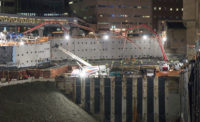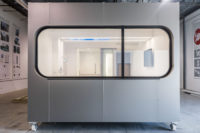Penn Med Rushes Philly Project For COVID-19 Care

Parts of Penn Medicine’s $1.5-billion Pavilion project in Philadelphia finished 15 months early to care for COVID-19 patients.
RENDERING COURTESY OF THE UNIVERSITY OF PENNSYLVANIA HEALTH SYSTEM
In mid-March, as the city of Philadelphia faced a potential hospital bed shortage from the spreading COVID-19 pandemic , the University of Pennsylvania Health System scanned its building inventory and targeted its $1.5-billion Pavilion project as part of the solution. With nearly a year left on the patient tower’s five-year schedule, Kevin Mahoney, CEO of the health system known as Penn Medicine, leaned on the project team to expedite work and bring beds on line fast. “Our CEO called me and asked how many rooms we could give him in 10 days,” recalls Steve Greulich, Penn Medicine associate vice president of capital projects. “He gave us 24 hours to figure it out.”
Multiple Pavilion teams, each representing a different area of the 17-story, 1.5-million-sq-ft project, huddled with subcontractors and pooled ideas. By the end of that day, they presented Mahoney with a range of options. The next morning, they had a plan: 60 emergency department rooms and 60 inpatient rooms in under two weeks.
With those additional rooms now complete, Greulich credits much of the team’s rapid response to the collaborative nature of its integrated project delivery method. “It goes back to the IPD team,” he says. “Numerous people have said that if we hadn’t gone through the last four years together on this project, we wouldn’t have been able to do this.”
In early March, before the design and construction industry was fully in the grip of the COVID-19 crisis, ENR MidAtlantic named Penn Medicine its Owner of the Year based on its history of “innovation and creativity throughout the region as well as their contributions to their community.” Weeks later, those qualities were on display at the Pavilion.
When fully operational next year, the Pavilion will add 500 private patient rooms and 47 operating rooms on Penn Medicine’s University City campus in west Philadelphia. The campus is home base for a $7.8-billion health system that extends into the greater Philadelphia region, including six major hospitals. In recent years, its capital program has averaged approximately $500 million annually for major construction projects.
Over the last three decades, Mack Stulb, president of locally based contractor L.F. Driscoll, has seen Penn Medicine evolve from an organization with a financially constrained capital program to one of the largest and most active health care owners in the nation. L.F. Driscoll has built numerous projects for Penn Medicine, including the Perelman School of Medicine, but the Pavilion is the system’s most ambitious one yet, Stulb says. L.F. Driscoll is part of the IPD team on the Pavilion, along with construction manager Balfour Beatty, designers HDR and Foster+Partners and engineers BR+A and Southland Industries.
“Our CEO called me and asked how many rooms we could give him in 10 days. He gave us 24 hours to figure it out.”
– Steve Greulich, Associate Vice President of Capital Projects, Penn Medicine
Stulb credits Penn Medicine’s Mahoney with embracing IPD and driving its use on the project. In 2012, while the Pavilion was still in planning, Mahoney, who was then executive vice president and chief administrative officer, convinced leaders at Penn Medicine to use IPD for the first time. In Mahoney’s view, the project would follow a “true IPD” model, sharing risks and rewards among the design and construction stakeholders.
“He really put his job on the line,” Stulb recalls. “It was a very bold move. But it doesn’t surprise me. He’s a very thoughtful and analytical guy, who challenges us every day.”
The team toured other IPD hospital projects around the country, including Parkland Hospital in Dallas, which HDR and Balfour Beatty completed in 2014. “Kevin [Mahoney] knew there had to be a better way to deliver a project of this magnitude, scale and complexity,” says Hank Adams, HDR global director of health. “What impressed me about him was that he took the time to really look at lessons learned from previous projects around the U.S. and built on best practices.”
One of those practices was the large-scale use of multi-trade prefabrication, which, at the time, had never been employed on a project in the Philadelphia market, according to the team. The strategy draws on having components built entirely in the city by union trades. It includes custom bathroom pods as well as multi-trade racks in roughly 25-ft sections that run through corridors, patient rooms and operating rooms.
Starting in early 2015, the team collaborated in a dedicated collocation space for more than 18 months before excavation started. One significant part of those early efforts included building a 30,000-sq-ft mock-up of a patient unit, representing roughly half of a full floor. “The focus wasn’t on the rooms and what goes on in the rooms. It was on the functionality of the space and the layout,” Greulich says. The team then involved more than 600 Penn Medicine staff members in the process, including about 150 people who were asked to participate in task simulations. “We found a number of things that were really problematic from a functionality standpoint,” he says. “We tossed out the design and started an intense redesign process. We took [the mock-up] down, built the new one and brought the same people back to test it. It would be a very different place now if we hadn’t done that.”
That spirit of teamwork and innovation is not unique to the Pavilion project. Greulich says Penn Medicine prefers to use more collaborative delivery methods on its large projects, rarely employing traditional design-bid-build delivery. The capital program has typically favored a construction manager at-risk method on large projects in recent years, although it has occasionally used design-build on projects that are “straightforward, not complicated and where speed is the goal,” Greulich says.
Robert Cottone, president and CEO of IMC Construction, has seen that evolution over the 18 years the firm has worked for Penn Medicine. Malvern, Pa.-based IMC’s first project was a straightforward medical office building. Since then, it has delivered more advanced work, such as a recently completed $143-million first phase of the Center for Healthcare Technology in Philadelphia. Designed by Perkins + Will, it includes 250,000 sq ft of space and 10 floors, with precast panels framing floor-to-ceiling glass. It was built with the ability to add 10 more floors and 290,000 sq ft of space in a second phase.
IMC is building a $163-million outpatient facility for Penn Medicine in Radnor, Pa. Slated to open this spring, the facility was put on hold in March when the state ordered all “non-life-sustaining businesses” to cease, in a move to stop COVID-19’s spread. The building will include heart and vascular care, cancer care, women’s health and orthopedic and rehabilitation medicine.
“Penn Medicine works in a very open, collaborative, transparent and integrated manner,” Cottone says. “They prefer to participate in a very intensive preconstruction process. Their goal is to solve problems and build the project virtually to debug it so when we break ground we’re just running a race to get it done.”
Although the Pavilion is still more than a year from completion, Greulich sees IPD as the future for the capital program’s large projects, replacing CM at-risk and other methods. “My goal is that relatively soon those types of projects wouldn’t be done in our traditional manner,” he says. “We’ll start implementing IPD across the board.”


